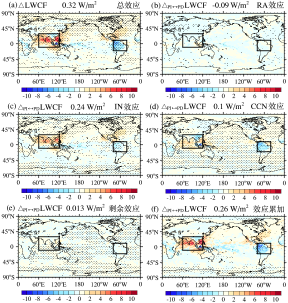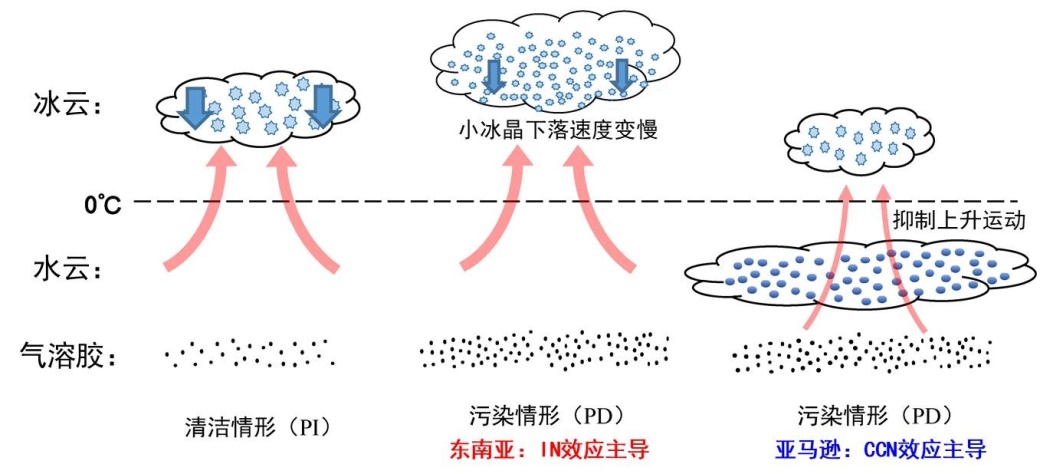Aerosol-cloud interaction is a key issue of climate change research. The change of aerosol can affect the cloud height, cloud amount and life time of the ice cloud by changing the radiant flux of the earth-atmosphere system, the thermodynamic conditions of the atmosphere, and the microphysical properties of the cloud. Due to the relatively complicated mechanism of aerosols on ice clouds, there are still great uncertainties in estimating the changes in longwave cloud radiative forcing caused by aerosols in climate models.
The research group of Associate Professor PENG Yiran, Department of Earth System Science, Tsinghua University, analyzed the effects of aerosol longwave cloud radiation, which is only roughly estimated but lacks a clear mechanism, and explained different dominant mechanisms of aerosols affecting longwave cloud radiative forcing in Southeast Asia and the Amazon through a series of simulation tests of the global climate model CAM5.3. The research results, entitled Contrasting aerosol effects on longwave cloud forcing in South East Asia and Amazon simulated with Community Atmosphere Model version 5.3, were recently published in the Journal of Geophysical Research-Atmosphere, a highly influential journal in the field of geosciences.
In this study, the two-way polarized radiation perturbation method was used in the simulation experiment to split the complex impact of aerosols on clouds into four effect items, namely RA (rapid adjustment process of aerosol-radiation interaction) effect, CCN (cloud condensation nuclear) effect, IN (ice nuclear) effect and residual effect. Among the decomposition terms of aerosols affecting the long-wave cloud radiative forcing (Figure 1), the CCN effect and the IN effect are particularly significant. The study found that the longwave cooling caused by aerosols in the Amazon is mainly dominated by the CCN effect, while the long-wave warming caused by aerosols in Southeast Asia is mainly dominated by the IN effect.

Figure 1. Aerosols influence the global distribution of longwave cloud radiative forcing and its decomposition items, including (a) total aerosol effect,
(b) RA effect, (c) IN effect; (d) CCN effect; (e) residual effect; (f) ) The accumulation of the four effects.
Among them, the CCN effect is mainly reflected in the increase of cloud condensation nuclei, which increases the albedo of warm clouds and causes surface cooling, thereby inhibiting the upward development of ice clouds, which is reflected in the long-wave cooling of the top of the atmosphere (see Figure 2 right). The IN effect is mainly reflected in the increase in the number of ice nuclei and the decrease in the size of ice crystals, and the slower falling speed of small ice crystal particles, so that the ice cloud can be maintained at a higher altitude and the life time of the ice cloud is prolonged (see Figure 2). This study reveals the specific mechanism of aerosols in the CAM5.3 model that affect the long-wave cloud radiative forcing in different regions, which helps to more reasonably assess the global climate impact of aerosols.

Figure 2 Schematic diagram of the dominant mechanism of aerosol-cloud interaction in Southeast Asia and the Amazon
Doctoral student WANG Minqi from DESS of Tsinghua University is the first author of the paper, Associate Professor PENG Yiran from DESS is the corresponding author of the paper, and Professor LIU Yangang from Brookhaven National Laboratory is the co-author of the paper. This research was supported by the Key R&D Project of the Ministry of Science and Technology (No. 2017YFC1501404), the National Natural Science Foundation of China (No. 41605106 and No. 41775137), and the Atmospheric System Research Program of the US Department of Energy.
Full text link:https://agupubs.onlinelibrary.wiley.com/doi/10.1029/2020JD032380
Writer: WANG Minqi
Review: WU Haiping
Editor: WANG Jiayin